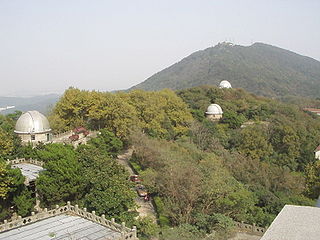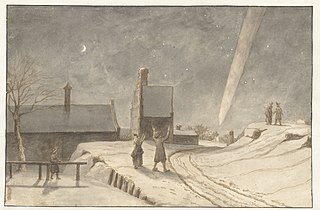Related Research Articles

32P/Comas Solà is a periodic comet with a current orbital period of 8.8 years.

David Howard Levy is a Canadian amateur astronomer, science writer and discoverer of comets and minor planets, who co-discovered Comet Shoemaker–Levy 9 in 1993, which collided with the planet Jupiter in 1994.
Richard Martin West is a Danish astronomer and discoverer of astronomical objects with a long career at the European Southern Observatory (ESO) and at the International Astronomical Union (IAU).

Comet West, formally designated C/1975 V1, 1976 VI, and 1975n, was a comet described as one of the brightest objects to pass through the inner Solar System in 1976. It is often described as a "great comet."
Jérôme Eugène Coggia was a 19th-century French astronomer and discoverer of asteroids and comets, who was born in the Corsican town of Ajaccio.

The Purple Mountain Observatory, also known as Zijinshan Astronomical Observatory is an astronomical observatory located on the Purple Mountain in the east of Nanjing.
Holger Thiele was a Danish American astronomer and discoverer of minor planets and comets.
Andrea Boattini is an Italian astronomer and a prolific discoverer of minor planets and comets.
Carl William Hergenrother is an American astronomer and discoverer of minor planets and comets.

A sungrazing comet is a comet that passes extremely close to the Sun at perihelion – sometimes within a few thousand kilometres of the Sun's surface. Although small sungrazers can completely evaporate during such a close approach to the Sun, larger sungrazers can survive many perihelion passages. However, the strong evaporation and tidal forces they experience often lead to their fragmentation.

Donald Edward Machholz was an American amateur astronomer who was credited with the discovery of 12 comets that bear his name.

Comet Machholz, formally designated C/2004 Q2, is a long-period comet discovered by Donald Machholz on August 27, 2004. It reached naked eye brightness in January 2005. Unusual for such a relatively bright comet, its perihelion was farther from the Sun than the Earth's orbit.

C/1680 V1, also called the Great Comet of 1680, Kirch's Comet, and Newton's Comet, was the first comet discovered by telescope. It was discovered by Gottfried Kirch and was one of the brightest comets of the seventeenth century.

The Eclipse Comet of 1948, formally known as C/1948 V1, was an especially bright comet discovered during a solar eclipse on November 1, 1948. Although there have been several comets that have been seen during solar eclipses, the Eclipse Comet of 1948 is perhaps the best-known; it was however, best viewed only from the Southern Hemisphere.

Comet Spitaler is a periodic comet in the Solar System discovered by Rudolf Ferdinand Spitaler on November 17, 1890, while attempting to observe Comet Zona.

Rudolf Ferdinand Spitaler was an Austrian astronomer, geophysicist, meteorologist and climatologist.

332P/Ikeya–Murakami is a short-period comet with period of approximately 5.4 years first identified independently by the two Japanese amateur astronomers Kaoru Ikeya and Shigeki Murakami on November 3, 2010. Ikeya identified the comet using a 25-centimeter (10-inch) reflector at 39×, while Murakami used a 46 cm (18-inch) reflector at 78×. Photographic confirmation of the comet was obtained by Ernesto Guido and Giovanni Sostero using a Global-Rent-a-Scope (GRAS) telescope in New Mexico. Both Ikeya and Murakami discovered the comet using manual observation through optical telescopes. Such visual discoveries have become rare in recent years.
Leonid Vladimirovich Elenin is a Russian amateur astronomer working with the ISON-NM observatory (H15) via the International Scientific Optical Network (ISON), which is the first Russian remote observatory in the West.
Temistocle Zona was an Italian astronomer.

Comet C/2018 V1 (Machholz–Fujikawa–Iwamoto) is a minor body that follows a slightly hyperbolic orbit. It was visually discovered on 7 November 2018 by Donald Machholz using an 18.5-inch reflecting telescope and it reached perihelion on 3 December 2018.
References
- ↑ Kronk, Gary W. (2003). "C/1890 V1 (Zona)". Cometography: A Catalog of Comets. Vol. 2: 1800–1899. Cambridge University Press. pp. 658–660. ISBN 0521585058.
- ↑ Osservazioni della Cometa 1890 IV (Zona Nov. 15)

